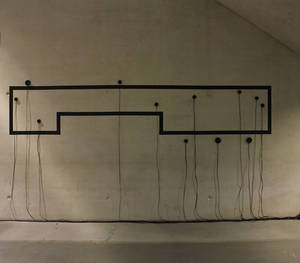Karin Fisslthaler
*1981 in Oberndorf (Salzburg), lebt und arbeitet in Linz und Wien
*1981 in Oberndorf (Salzburg), lives and works in Linz and Vienna
2012: The Third Place – Karin Fisslthaler and Bernd Oppl, Kunstraum Goethestrasse xtd, Linz
Internationales Kurzfilmfestival Hamburg (screening)
2011: Diagonale - Festival des österreichischen Films in Graz (screening)
2010: Expedition Sonar, Lentos Kunstmuseum Linz
In Between. Austria Contemporary, 4.International Beijing Biennale
LENTOS Noise Map
2010, 12-channel audio installation (12 mini-speakers,12 MP3 players, black Gaffa tape), variable dimensions

Jede Architektur produziert ihr eigenes Klangbild, das durch unterschiedlichste Quellen gespeist wird, sich permanent verändert und unterschiedlichst
rezipiert wird - so entsteht eine spezifische „Sound Signature”. Diese Signatur
zu entdecken und sie künstlerisch interpretiert zu „hören”, war Motivation, Aus-
gangpunkt und Grundidee für die akustische Vermessung des LENTOS Kunst-
museum in Linz. Bahnhöfe geben sich durch Zuggeräusche, das Summen von Menschengewirr, das Tönen von Lautsprecherdurchsagen zu erkennen; Schulen durch das Lärmen von Kindern, die Pausenglocke, das Quietschen im Turnsaal.
Die Klangspektren sind zuordenbar und erlernt. Aber wie klingt ein Museum? Es ist meist nichts Spezifisches: Das Murmeln von BesucherInnen, das Tönen von Klang- oder Medienarbeiten ist nichts, was eine eindeutige Zuschreibung zulässt. Auf der Expedition durchs Haus ist der Klang entdeckt worden - es tönt hinter den Kulissen an allen Ecken und Enden. Die Maschine Museum brodelt, stampft, surrt oder wummert. (Magnus Hofmüller/ Kurator Raum LENTOS)
Every architecture produces a sonic image of its own, which draws from manifold sources, permanently changes and is very differently received - thus resulting in a specific “sound signature”. Discovering this signature and “listening” to it in an artis-
tic interpretation was the motivation, starting point and basic idea for the acoustic survey of LENTOS art museum in Linz. Train stations can be recognized by the
noise of trains, the buzzing of crowds of people, announcements sounding through the PA systems; schools by the noise of children, the bell, squeaking sounds in the gym. The sonic spectrums can be attributed and learned. But what is the sound of
a museum? It is usually nothing specific: the murmuring of visitors, the sound from media or acoustic works is not something that can be unequivocally attributed. This sound has been discovered in the course of an expedition through the house - it reverberates behind the scenes in every corner. The machine museum burbles, stomps, whirs or booms. (Magnus Hofmüller/ curator Raum LENTOS)



